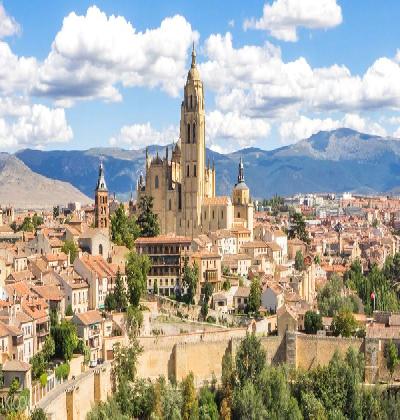Segovia
 Segovia is a city in Spain, which is the administrative center of the province of the same name. It is located 90 km northwest of Madrid between the Clamores and Eresma rivers on a rocky hill. Segovia is located on a high rock between the Eresma and Clamores rivers, being one of the most attractive cities in northern Spain. In the center of the Old City, surrounded by a walled fortress, there is a cathedral and in the northwest stands the Alcazar, which is considered one of the most beautiful fortresses in Spain. In the eastern part of the city there is an aqueduct that extends directly over the roofs of Segovia, the best Roman monument on the peninsula. In addition, there are more than 15 Romanesque churches in Segovia.
Segovia is a city in Spain, which is the administrative center of the province of the same name. It is located 90 km northwest of Madrid between the Clamores and Eresma rivers on a rocky hill. Segovia is located on a high rock between the Eresma and Clamores rivers, being one of the most attractive cities in northern Spain. In the center of the Old City, surrounded by a walled fortress, there is a cathedral and in the northwest stands the Alcazar, which is considered one of the most beautiful fortresses in Spain. In the eastern part of the city there is an aqueduct that extends directly over the roofs of Segovia, the best Roman monument on the peninsula. In addition, there are more than 15 Romanesque churches in Segovia.
In 80 B.C. the Celtic settlement of Segobriga was conquered by the Romans and became an important center of commerce in the 10th-13th centuries. Segovia, on the border between the Arab and Christian states, constantly changed hands until Segovia was finally freed from the Muslims. However, after it was retaken by the Christians, in 1088 the Castilian king Alfonso VI moved his court here. In 1474, Isabel de Castilla was crowned in the Church of San Miguel. In 1480, Segovia was the residence of the Grand Inquisitor of Torquemada. Segovia from the XIX-XX century is famous as the "city of poets"; Thanks to its proximity to Madrid, it becomes a favorite resting place for Madrid residents. It was the home of the famous poet Machado. Thanks to its historical and architectural monuments, Segovia has received the status of a UNESCO World Heritage Site.
The zenith of Segovia's glory reached its peak in 1474, when in the cathedral of San Miguel Isabel la Católica was proclaimed Queen of Castile. During the Habsburg period (16th-17th centuries) the city fell into decline and was not reborn until the 18th century.
Roman aqueduct:
The Roman aqueduct is a symbol of Segovia, a monumental ancient structure, which is a Unesco World Heritage Site. It was built in the 50s A.D. during Flavio's reign. This ancient engineering structure has stood the test of time and is in excellent condition. Its construction includes more than 20 thousand granite blocks and 167 arches. The Aqueduct is one of the largest Roman structures in Spain and was built to supply water from the Azebeda river to the ancient city.
Alcazar:
El Alcázar is one of the most beautiful and famous places of interest in Segovia, a majestic medieval fortress on a steep rock. Some believe that its architecture is reminiscent of a Castle taken from a fairy tale. Originally it was a military fortress. The existing castle was built in the 12th century and served as the residence of Alfonso VIII and other Castilian kings. The castle was enlarged in the Gothic style in the 13th century. The last reconstruction dates back to the 16th century. The entrance to the castle is in the Tower of Juan II, a 14th century tower surrounded by ten semicircular towers. The climb to the Tower of Juan II will reward you with the impressive views of Segovia.
Jewish sweep:
Like many ancient Castilian cities, Segovia had a fairly large Jewish community. The Old Jewish Quarter is located in Plaza de la Merced and fascinates with its unique medieval atmosphere. Here you can see fragments of an old synagogue, visit the Museum of Fine Arts and stroll through a maze of ancient streets.
The Royal Mint:
The Royal Mint is one of the oldest commercial buildings in Spain. It was founded in the 16th century by Felipe II and designed by Juan de Herrera. It is now home to a museum.
The House of the Peaks:
The Casa de los Picos is a 15th century aristocratic mansion with an unusual facade. It is now home to an art school and an exhibition hall.
Royal Palace in San Ildefonso:
The Royal Palace of San Ildefonso can be called the Spanish Versailles. It was built in the 18th century by Felipe V as a royal residence. The palace is an excellent example of French Baroque. Visitors can see the throne room and luxurious halls, magnificent Flemish, French and Spanish tapestries, the church with the marble tomb of Felipe V. The Royal Palace is located in the city of San Ildefonso, 10 km from Segovia.




